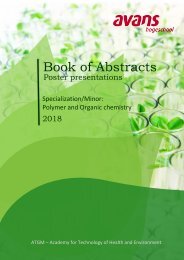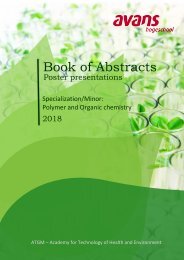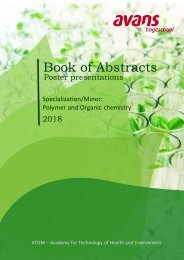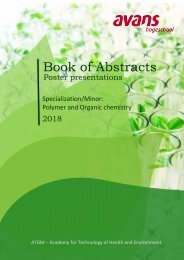Book of abstracts version 5
You also want an ePaper? Increase the reach of your titles
YUMPU automatically turns print PDFs into web optimized ePapers that Google loves.
<strong>Book</strong> <strong>of</strong> <strong>abstracts</strong> SPOC 2018<br />
Synthesis <strong>of</strong> Poly(Glycerol Succinate – Co – Maleate) PLA enhancer 2<br />
Author<br />
oly(Glycerol Wim van der Pluijm Succinate – Co – Maleate) PLA enhancer 2<br />
Academy <strong>of</strong> Technology for Health and Environment<br />
Avans Hogeschool, Breda<br />
Abstract<br />
Using fossil fuels to create plastics bring many disadvantages, both the production and products created are harmful to<br />
the environment. Because <strong>of</strong> this many replacements are currently being explored. One <strong>of</strong> such replacements is the use <strong>of</strong><br />
bio-degradable polymers, their range <strong>of</strong> use however is very limited because <strong>of</strong> their physical properties. Luckily it is<br />
possible to enhance the properties <strong>of</strong> these polymers to increase their range <strong>of</strong> use by adding another polymer. The goal<br />
<strong>of</strong> this study is to thoroughly analyse the synthesis <strong>of</strong> the PLA enhan cer: PGSMA (Poly(Glycerol Succinate-Co-Maleate) [1]<br />
so that in further research the accent can be set on actually adding it to PLA and no difficulties/hurdles will be found at<br />
the synthesis. PGSMA is a polyester made out <strong>of</strong> glycerol, succinic acid and maleic anhydride where the double bond <strong>of</strong><br />
maleic anhydride makes it addable to PLA through reactive extrusion [2]. The synthesis will be done under N 2 and<br />
mechanical stirring at different temperatures, replacements for maleic anhydride will also be tested (see Figure 1).<br />
Heating the mixture at 180°C will create a three dimensional product and heating at 150 °C will create a linear product.<br />
The maleic anhydride replacements are: fumaric acid and itaconic acid (better for environment). During the synthesis<br />
samples will be taken and analysed with FTIR, DSC & GPC to determine the progress and speed <strong>of</strong> the reaction. At 180 °C<br />
this is to determine the gel point so that the synthesis will not go beyond that (the product becomes unusable).<br />
Keywords: PLA enhancer, PGSMA, Reactive extrusion, gel point.<br />
Table <strong>of</strong> content<br />
Figure 1: Overview study.<br />
[1] Valerio, Oscar, et al. “Sustainable Biobased Blends <strong>of</strong> Poly(Lactic Acid) (PLA) and Poly(Glycerol Succinate-Co-Maleate)<br />
(PGSMA) with Balanced Performance Prepared by Dynamic Vulcanization.” RSC Advances, vol. 7, no. 61, 2017, pp. 38594 –<br />
38603., doi:10.1039/c7ra06612k.<br />
[2] Valerio, Oscar, et al. “Synthesis <strong>of</strong> Glycerol-Based Biopolyesters as Toughness Enhancers for Polylactic Acid Bioplastic<br />
through Reactive Extrusion.” ACS Omega, vol. 1, no. 6, 2016, pp. 1284–1295., doi:10.1021/acsomega.6b00325.<br />
33









